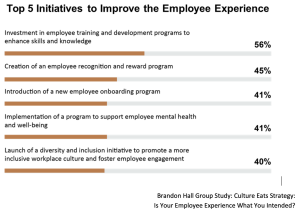Guest post by Matt Pittman of Brandon Hall Group
The age of the experience economy has driven many changes in how companies do business with customers, how employers treat employees and how workers engage with learning opportunities.
Simply put, how an individual experiences any aspect of your organization drives their perception and loyalty. For employers, crafting and maintaining a positive employee experience has become a business imperative.
Brandon Hall Group’s 2023 study, Culture Eats Strategy: Is Your Employee Experience What You Intended?, probed deeply into employer and employee perceptions of the employee experience. The study revealed that most (67%) respondents are likely to refer someone to work for their organization. Almost that same percentage (68%) report that they are either Satisfied or Very Satisfied with the current employee experience provided by their company. Interestingly, that number shifts dramatically outside of North America with just under half (47%) responding that they are Satisfied or Very Satisfied.
Not surprisingly, technology is a critical dimension of the employee experience, easily elevating it to great heights or disrupting it with far-reaching consequences. Organizations need engaged, motivated employees to drive innovation and business results. The workforce needs support to continue to grow and develop along with the changes in how work is being done. Because of this convergence, we know that one of the most impactful ways companies can empower a positive employee experience is through learning technology.
Effective learning technology provides on-demand development opportunities that employees can easily access. This allows workers to take control of their own learning and development to the extent possible while still maintaining company and regulatory requirements. In fact, investment in employee training and development programs to enhance skills and knowledge is the highest-rated initiative globally to improve the employee experience, outpacing the second-highest item by 11 percentage points overall. That margin jumps to 18% outside of North America. Providing easy access to learning technology shows employees that the organization values their growth.

With quality learning technology, employees can upskill quickly on topics relevant to their roles and interests. Curated content, personalized recommendations and intuitive platforms allow for self-directed learning. Employees might learn a new skill to increase productivity or take a course on management tactics before transitioning to a leadership position. The ability to quickly build capabilities empowers employees to take on new challenges and progress in their careers.
Learning technology also enables social and collaborative learning through features like discussion boards, peer coaching and mentor matching. This connects employees, allowing them to share knowledge and learn from each other. Collaborative learning fosters teamwork, relationships and a sense of community. It also reduces organizational silos. Employees feel valued when organizations provide opportunities for peer knowledge sharing and relationship building.
Data and analytics embedded in learning technology provide insights into skill gaps across the employee base. Leadership can use this data to develop training programs that target key competency gaps. Focused development empowers employees to gain the most relevant skills to advance their careers and deliver impact in their roles. Data also helps assess the effectiveness of learning programs to ensure optimal resource utilization.
Where and how work gets done has shifted. Between deskless workers in more hands-on environments to the ever-growing remote and hybrid workforce, learning technology brings development opportunities to employees wherever they are. Online learning platforms allow access to courses, videos, virtual instructor-led sessions and more. This provides flexibility for employees to learn in the flow of work. Adaptability and self-service learning resources empower employees to develop skills how and when they want.
Learning technology also enables consistent onboarding and training for new hires. Multimedia learning content engages learners and allows new employees to ramp up quickly. Onboarding learning tracks prepare employees for success in their new roles. Ongoing training empowers continued growth and development. Consistent learning opportunities lead to greater employee competencies across the organization.
To truly empower employees, organizations need learning technology platforms that are intuitive and easy to use. Complex platforms with a steep learning curve lead to frustration. User-friendly interfaces with personalized dashboards allow employees to easily navigate learning. Technology that freely allows users to search courses and content promotes utilization. Seamless mobile functionality empowers employees to learn on the go.
Technology is at once the great enabler and the great disrupter. When looking at strategies to improve your employee experience, consider all dimensions of that experience and your approach to it. Start by asking yourself the following questions.
- Does our culture encourage collaboration and provide support for growth?
- How frequently are we surveying our team members for their feedback and perspective?
- How can we better leverage our existing technology to ensure ease of use and therefore, promote utilization among our workforce?
- How can we better leverage emerging data technologies to gain greater insights into our employment experience using our existing employee data?
- Are we treating our employee experience like a key business outcome or a “nice to have” initiative?
Brandon Hall Group™ Bronze Smartchoice® Preferred Provider Totara Learning brings all these dimensions together with their Talent Experience Platform. Combining the core of enterprise learning management with a truly collaborative learning experience and linked to advanced performance management, Totara’s Talent Experience Platform (TXP) provides the configurability, integration capability and power needed by the business while delivering a seamless experience for the learner.
When your development technology is effective, it also supports a collaborative and supportive culture. This single element consistently ranks highest among attributes that contribute to a positive employee experience. Ensuring a culture remains collaborative and supportive requires intention on the part of all involved. It begins with clearly defining organizational expectations around a collaborative work environment — what it looks like in the specific context of your company and how it plays out in daily work.
Once you set those expectations, holding leaders accountable to behave in alignment to those expectations becomes critical. This does not necessarily need to be punitive in nature, but empowering leaders to point out in real-time when someone is acting contrary to expectations. Over time, this helps reinforce the intended culture. It might look like simply saying, “Hey — when you ask questions of the team but don’t wait from them to respond, that tends to shut down collaboration — and that’s not how we want to lead here.”
Culture change of this nature is not a 0 – 60, one-and-done proposition. It takes simple, clear intention and repetition over time. Be in it for the long haul to reap the true benefits.
Always remember that the employee experience is ultimately an outcome of many different factors. As such, it should be a filter on every decision being made in the business. “How does/will this affect our employees?” is a question leaders should be including standard in any decision-making effort.
Creating an employee experience/employee value proposition scorecard and reviewing it periodically throughout the year can help keep your leadership team honest and focused on these considerations. It is important to consider because positive employee experience is directly related to positive employee engagement, which has a documented impact on discretionary effort and subsequent business performance.
Implementing the right learning technology shows employees that their development matters. This empowers engagement, improves retention and enables a positive work experience. But technology alone is not enough — organizations should promote a continuous learning culture through manager support, learning incentives and an emphasis on development in core values. Paired with the right culture, learning technology gives employees development autonomy. This leads to an empowered, agile workforce that can drive innovation and thrive amidst ongoing change.






